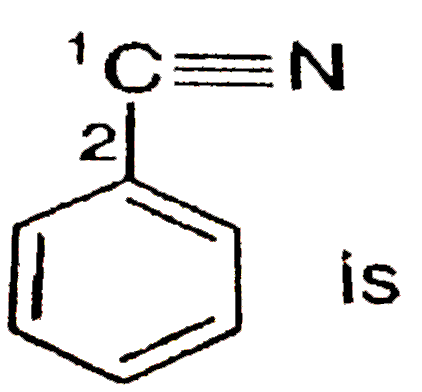The bond length between central carbon atom and other carbon atom is minimum in
Propene
Propyne
Propane
pentane
The correct Answer is:2
To determine the bond length between a central carbon atom and another carbon atom, we need to analyze the types of bonds formed between them: single, double, and triple bonds. The bond length is influenced by the bond type, which is related to the hybridization of the carbon atoms involved.
1. Identify the Types of Bonds:
- The three types of carbon-carbon bonds we will consider are:
- Single bond (C-C)
- Double bond (C=C)
- Triple bond (C≡C)
2. Understand Hybridization:
- The hybridization of the carbon atoms affects the bond length:
- Single bond (C-C) involves sp³ hybridization.
- Double bond (C=C) involves sp² hybridization.
- Triple bond (C≡C) involves sp hybridization.
3. Calculate Percentage s Character:
- The percentage of s character in the hybridization affects bond strength and length:
- For sp³ (single bond): 25% s character
- For sp² (double bond): 33% s character
- For sp (triple bond): 50% s character
4. Analyze Bond Strength and Length:
- The greater the s character, the shorter and stronger the bond:
- Triple bond (C≡C) has the highest s character (50%), making it the shortest and strongest bond.
- Double bond (C=C) has 33% s character, making it longer than a triple bond but shorter than a single bond.
- Single bond (C-C) has the least s character (25%), making it the longest and weakest bond.
5. Conclusion:
- Therefore, the bond length between the central carbon atom and the other carbon atom is minimum in a triple bond (C≡C).
Final Answer:
The bond length between the central carbon atom and the other carbon atom is minimum in a triple bond.
---
- The three types of carbon-carbon bonds we will consider are:
- Single bond (C-C)
- Double bond (C=C)
- Triple bond (C≡C)
- The hybridization of the carbon atoms affects the bond length:
- Single bond (C-C) involves sp³ hybridization.
- Double bond (C=C) involves sp² hybridization.
- Triple bond (C≡C) involves sp hybridization.
- The percentage of s character in the hybridization affects bond strength and length:
- For sp³ (single bond): 25% s character
- For sp² (double bond): 33% s character
- For sp (triple bond): 50% s character
- The greater the s character, the shorter and stronger the bond:
- Triple bond (C≡C) has the highest s character (50%), making it the shortest and strongest bond.
- Double bond (C=C) has 33% s character, making it longer than a triple bond but shorter than a single bond.
- Single bond (C-C) has the least s character (25%), making it the longest and weakest bond.
- Therefore, the bond length between the central carbon atom and the other carbon atom is minimum in a triple bond (C≡C).
The bond length between the central carbon atom and the other carbon atom is minimum in a triple bond.
Topper's Solved these Questions
- HYDROCARBONSBOOK - AAKASH INSTITUTECHAPTER - HYDROCARBONSEXERCISE - Assignment(Section - D) (Assertion -Reason Type Question)
24 Videos
- HYDROCARBONSBOOK - AAKASH INSTITUTECHAPTER - HYDROCARBONSEXERCISE - Assignment(Section - B) (Obejctive type question)
13 Videos
- HALOALKANES AND HALOARENES BOOK - AAKASH INSTITUTECHAPTER - HALOALKANES AND HALOARENES EXERCISE - ASSIGNMENT SECTION -D
15 Videos
- HYDROGENBOOK - AAKASH INSTITUTECHAPTER - HYDROGENEXERCISE - ASSIGNMENT (SECTION - D) (Assertion-Reason Type question)
15 Videos
Similar Questions
Knowledge Check
The bond length between hybridised carbon atom and other carbon atom is minimum in
ApropeneBpropyneCpropaneDbutaneIn which of the following compounds, the bond length between hybridised carbon atom and other carbon atom is minimum?
AButaneBPropyneCPropeneDButeneIn which of the following compounds, the bond length between hybridised carbon atom and other carbon atom is minimum?
AButaneBPropyneCPropeneDButane
The bond between carbon atom (1) and carbon atom (2) in compound

View SolutionCarbon forms bonds with other atoms
View SolutionThe bond between carbon atom 1 and carbon atom 2 in a compound N≡C−CH=CH−CH3 involved the hybrids as :
View SolutionThe central carbon atom of a free radical contains
View SolutionThe bond between carbon atom (1) and carbon atom (2) in compound N≡C1−CH2=CH2, involves the hybridization as
View Solution
